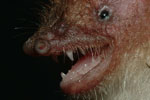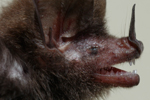First identified in 2005, white-nose syndrome has killed over a million bats in the US, pushing once common species to the edge of collapse and imperiling already-endangered species. Striking when bats hibernate, the disease leaves a white dust on the bat’s muzzle, causing them to starve to death. Long believed to be caused by a fungus in the genus Geomyces, researchers publishing in Nature have confirmed that the disease is produced by the species, Geomyces destructans.
“By identifying what causes white-nose syndrome, this study will greatly enhance the ability of decision makers to develop management strategies to preserve vulnerable bat populations and the ecosystem services that they provide in the U.S. and Canada,” said Anne Kinsinger, Associate Director of Ecosystems with the US Geological Survey (USGS).
.360.jpg) Little brown bat with white-nose syndrome in Greeley Mine, Vermont, March 26, 2009. Photo by: Marvin Moriarty/USFWS. |
To confirm that Geomyces destructans was the fungal species in questions, researchers tested the species on bats in a laboratory. They also found that the disease is not airborne, but likely infects other bats when they fly in close formation brushing against one-another.
White-nose syndrome has been recorded in 16 states and 4 Canadian provinces, and it is still spreading. In the US’s Northeast, where the disease was first discovered, 80 percent of bats have died.
“While our study confirmed that G. destructans is spread bat-to-bat, it is also important to note that virtually all pathogens, especially spore-producing fungi, are spread by multiple routes,” said David Blehert, USGS microbiologist and co-author. “This is the reason that in an effort to further control the spread of white-nose syndrome, resource management agencies have implemented universal precautions, including limiting human access to sensitive environments occupied by bats, decontaminating equipment and clothing moved between these environments, and restricting the movement of equipment between sites.”
Bats play a big economic role in North America. As insect-eaters they help farmers control pest populations, providing ‘free’ ecosystem services worth billions.
CITATION: Jeffrey M. Lorch,
Carol U. Meteyer,
Melissa J. Behr,
Justin G. Boyles,
Paul M. Cryan,
Alan C. Hicks,
Anne E. Ballmann,
Jeremy T. H. Coleman,
David N. Redell,
DeeAnn M. Reeder
& David S. Blehert. Experimental infection of bats with Geomyces destructans causes white-nose syndrome. Nature, 2011. doi:10.1038/nature10590.
Related articles
Photos: three bizarre bats discovered in Southeast Asia

(10/30/2011) In the forests of Cambodia and Vietnam, researchers have discovered three new species of tube-nosed bats, known for extraordinary nostrils that look like blooming flowers. The new bats, described in the Journal of Mammalogy, are likely imperiled by deforestation. “They all possess specially shaped nostrils (hence the name for the group) the exact role of which not known yet,” Gabor Csorba, lead author of the paper with the Hungarian Natural History Museum, told mongabay.com.
Photos: new bat uncovered in the Caribbean

(05/26/2011) Researchers have declared a new species of bat from the Caribbean island of St. Vincent. While the new bat had been documented before, it was long believed to be a member of a similar species that is found throughout South America and a few Caribbean Islands, that is until PhD student Peter Larsen noticed it was far larger than its relative down south.
(04/03/2011) US agriculture stands to lose billions in free ecosystem services from the often-feared and rarely respected humble bat. According to a recent study in Science bats in North America provide the US agricultural industry at least $3.7 billion and up to a staggering $53 billion a year by eating mounds of potentially pesky insects. Yet these bats, and their economic services, are under threat by a perplexing disease known as white-nose syndrome (WNS) and to a lesser extent wind turbines.







